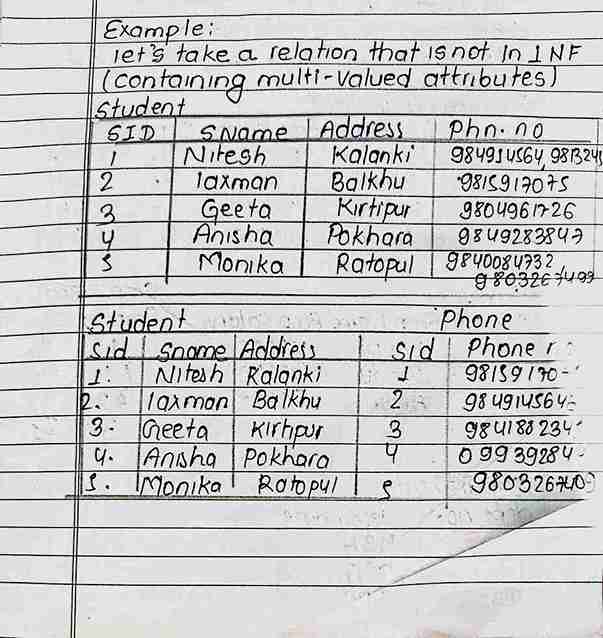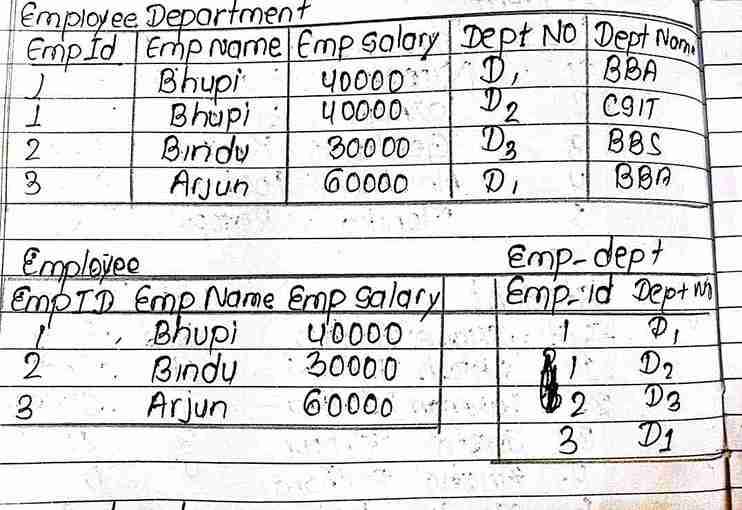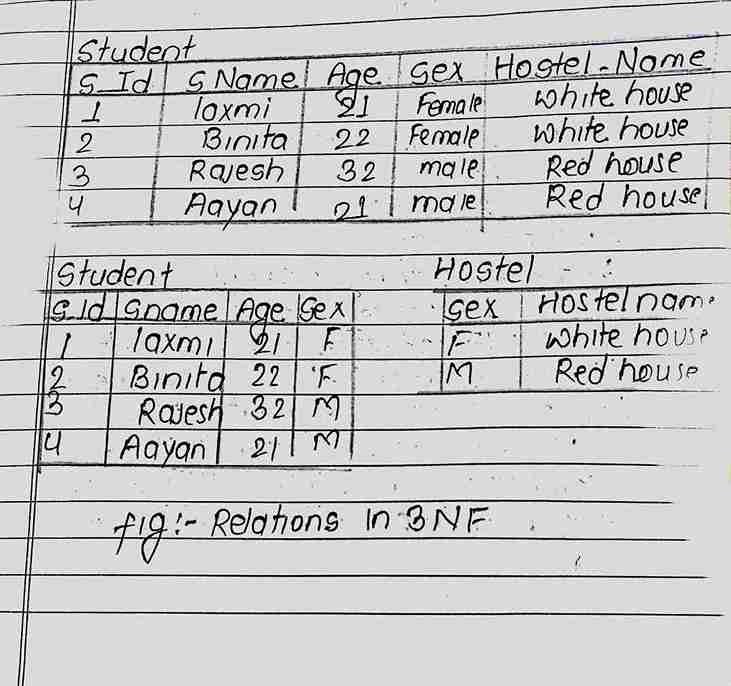Table of Contents
Group ‘A’
[ All the model questions solution DBMS are provided below]
1. Define data independence.
Answer: It refers to the capacity to change schema at one level of a database system without having to change the schema at next higher level.
2. What is specialization?
Answer: It is a top-down approach of creating subclasses from a higher level super class in an E-R model.
3. What are the uses of keys in database?
Answer: Keys are used to uniquely identify any record or row of data from the tables and establish relationship between tables.
4. What is DDL?
Answer: Data Definition Language is a a SQL used to create, modify the structure of database objects.
5. What is functional dependency?
Answer: It is a relationship that exists when one attributes uniquely determine another attributes.
6. Define serializable data.
Answer: The data that can be transformed into a format that can be stored or transmitted is called serializable data.
7. List desirable properties of transactions.
Answer: The desirable properties of transactions are;
ACID;
- Atomicity
- Consistency
- Isolation
- Durability
8. What is deferred update?
Answer: It is a technique for the maintenance of the transaction log files of the DBMS.
9. What is shadow paging?
Answer: It is a recovery technique that is used to recover database where database is considered as made up of fixed size of logical units of storage which are referred as pages.
10. Define bigdata.
Answer: It is the data that contains greater variety, arriving in increasing volumes and with more velocity.
Group ‘B’
[model questions solution DBMS]
11. Explain different characteristics of specialization and generalization.
Answer: Characteristics of specialization;
- It is a top-down approach
- It supports multiple inheritance in overlapping specialization.
Characteristics of generalization;
- It is a bottom-up approach.
- It is used when different entities share common attributes.
12. Explain different types of relationship sets in brief.
Answer: some of the types of relationship sets are;
- Unary relationship: Only one entity set participates in relationship
- Binary relationship: Two entity sets participate
- Nary relationship: More than two entity sets are involved
13. Explain any three data types in SQL with example.
Answer: The three data types in SQL are;
- Numeric data
- character data
- Date/ time data
14. What are the properties of relational decomposition?
Answer: The properties of relational decomposition are;
- Attribute preservation: all attributes from table must exist in decomposed table after decomposition.
- Redundancy reduction: There is reduction in data repetation.
- Dependency preservation: All functional dependencies are maintained after decomposition.
15. How do you recover the data from catastrophic failure?
Answer: A catastrophic failure is one where a stable, secondary storage device gets corrupt. Data can be recovered from catastrophic failure in following ways;
- Remote backup and Minu: Here a backup copy of database is stored at a remote location from where it can be restored in case of catastrophe.
- Alternatively, database backups can be taken on magnetic tape and stored at a safer place. This backup can later be transferred onto a freshly installed database to bring it to the point of backup.
16. Explain recovery technique based on immediate update.
Answer: It is a technique for the maintenance of transaction log files of the DBMS. Whenever any transaction is executed, the updates are made directly to the database , and the log file is also maintained which contains both old and new values. Once commit is done, all changes get stored permanently and records in log files are discarded. Once rollback is done the old values get restored in database and all changes made in database are discarded. This is called un-doing process. If the commit is done before crashing the system, the after restarting the system the changes are stored permanently in database.
Group ‘C’
17. Explain three-schema architecture of database in detail.
Answer: The three schema architecture are explained below:
- Internal level: The internal level has an internal schema, which describes the physical storage structure of the database.
- Conceptual level: It has conceptual schema, which describes the structure of the whole database for a community of users.
- External level: It includes a number of external schemas or user views. It describes the part of database that a particular user group is interested in. .
19. What is concurrency control? Explain two-phase locking protocol.
Answer: It is a process in DBMS to make sure that multiple transaction occurring simultaneously don’t interfere with each other. The two phase locking protocol is used to ensure serializability in database. This protocol is implemented in two phases:
- Growing Phase: New locks on data items may be acquired but none can be released.
- Shrinking Phase: Existing locks may be released but no new locks can be acquired.
20. Define data warehouse. Explain data mining with example.
Answer: A data warehouse is a storage of large amount of operational data gathered from multiple source stored under a unified schema at a single site.
Data mining is the process of extracting useful data from large sets of data. Data mining is digging through big piles of data to find valuable patterns, information useful for decision making. Data mining is useful in the field of banking, healthcare, social media.
Example: YouTube recommending videos on the basis of the basis of what you’ve watched before.
Group ‘D’
[Please use these model questions solution DBMS as a reference only]
21. Why do we need normalization in database? Explain 1NF, 2NF AND 3NF with examples.
Answer: Normalization is a database design technique that reduces data redundancy and eliminate undesirable characteristics like insertion, update and deletion anomalies The 1NF, 2NF, 3NF are explained below;
- First Normal Form(1-NF): It deals with the shape of the record type. A relation is in 1NF if, and only if, it contains no repeating attributes or group of attributes. For example:

- Second Normal Form(2-NF): A relation is said to be in 2-NF if and only if it is already in 1-NF. For example:

- Third Normal Form( 3-NF): A relation is said to be in 3-NF if and only if it is already in 2NF. No non-prime attributes is transitively dependent on primary keys of the relation. For example:

22. Consider a university database with three tables, where the primary keys are underlined as given below:
Student(SID, SName, SAddress, SEmail)
Studies(SID, CID)
Course(CID, CName, Credit hours)
Give an expression in SQL for each of the following queries;
a) Insert data with values “S101”, “Ram”, “Lalitpur” and “ram@abc.com” in student table.
Answer: Insert into student(SID, SName, SAddress, SEmail) values ( S101, ‘Ram’, ‘Lalitpur’, ram@abc.com);
b) find name of all the students whose address is “Kathmandu”.
Answer: Select *from student where address=’Kathmandu’;
c) find name of all students who study ” Database Management System”.
Answer: Select *from student where studies=’database management system’;
Note: You can find model questions here:https://www.fomecd.edu.np/cms/dhurbas/BBA%20BIM%20BBM%202nd%20Semester%20Model%20Question%20All.pdf
For more solutions, please visit:https://managementstudent.com/
Hope these questions solution DBMS will serve you for greater purpose.
